According to Hindu Dharma, we are all offsprings of Lord Brahma. Brahma is a male deity who creates but neither preserves nor destroys anything. He is projected to have emerged from the metaphysical Brahman along with Lord Vishnu (preserver), Lord Shiva (destroyer), and all other gods, goddesses, matter, and other beings.
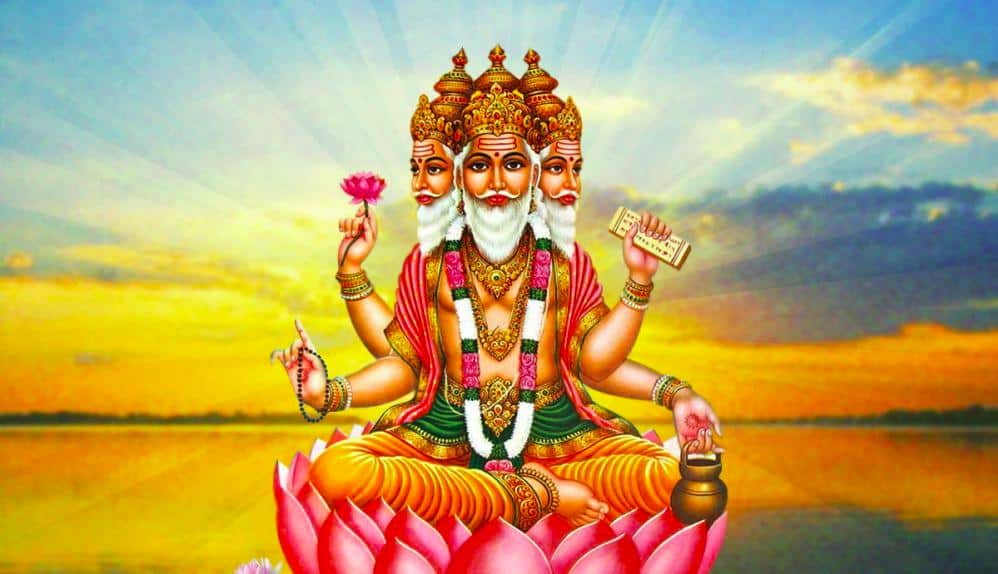
After the creation of the world from the cosmic egg, Lord Brahma was busy in creating various forms of Gandharva, Yaksha, Kinnara, Kimpurusha, Rakshasa, Nagas, Suparna, Vanaras, Vidyadhara, Valkyria, Pisacha, Devas, Asuras and Human beings. He is said to have created human beings as an image of the gods. Thus, 4 sages or Kumaras were born.
The Four Kumaras
They were Sanaka, Sanandana, Sanatana, and Sanatkumara. Brahma had experienced the sight of Lord Vishnu sleeping on the back of Ananta Shesha after performing penance for thousands of years. Lord Vishnu pleased with his penance gave to him the basic knowledge of the Veda. Only after getting that knowledge, he commenced his creation.
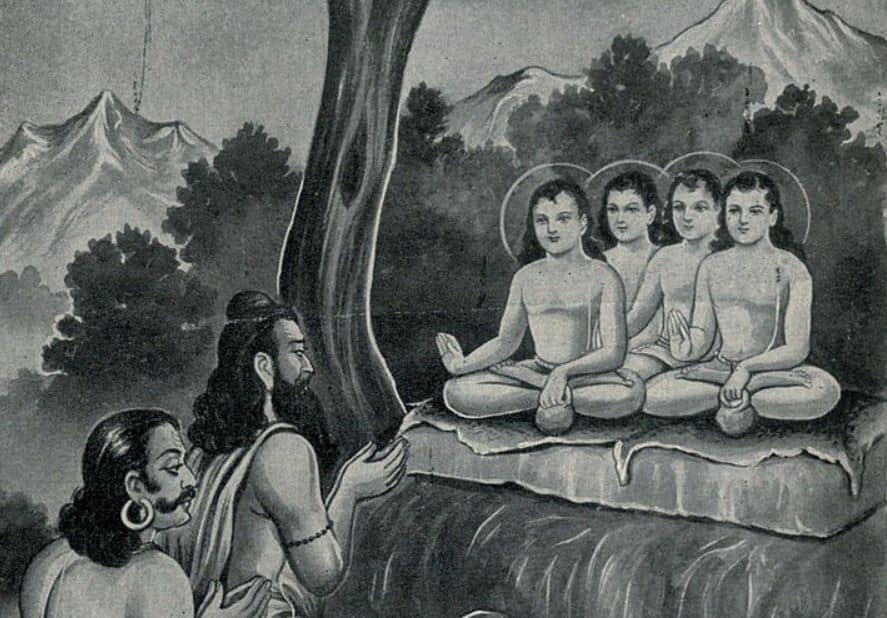
When the four Kumaras came into existence, they were all embodiments of pure qualities. They did not have any signs of negative qualities like laziness, sleep, etc. Brahma had created these four Kumaras so that they could help in the process of creation. But they refused when they were ordered by Brahma to do so. So these four Kumaras—kumara means unmarried brahmacharis. Because in the beginning Brahma begot so many sons, and each of them was asked to increase the population.
Sanaka, Sananda, Sanatana, were also requested by their father to increase the population, but they refused and chose to remain kumaras and brahmacharis, and preach the glories of God. Brahma became angry. And while he was angry, from his anger Rudra, Siva, was said to have been produced from his forehead.
Characters of the Kumaras
They requested their father for the boon of remaining perpetually five years old along with being celibate.
Their names were Sanaka (Ancient), Sanandana (Joyful), Sanatan (eternal), and Sanatkumara (Ever young). They lead a life of ascetics and roamed around of their free will with their cosmic powers all over the universe.
The four Kumaras learned the Vedas at the age of four or five.
Due to the boon from their father Brahma and the strength of their tapas, the Four Kumaras looked like 5-year-olds. Jaya and Vijaya, the gatekeepers of the Vaikuntha stopped the Kumaras at the gate, thinking them to be children. They told the Kumaras that Sri Vishnu is resting and that they cannot see him now. The enraged Kumaras cursed both Jaya and Vijaya that they would have to give up their divinity, be born as mortals on Earth (Bhuloka), and live like normal human beings.

This curse was eventually ‘diluted’ to Jay and Vijaya choosing to be born three times on Earth as enemies of Vishnu. They were soon to be born as Hiranyaksha and Hiranyakashyapu.
Nārāyaṇamukhambhojānmantrastvaṣṭādaśākṣaraḥ|
Āvirbhūtaḥ kumāraistu gṛhītvā nāradāya ca||
– Gopalatapinyupaniṣad of the Atharva Veda.
This holy eighteen-syllabled mantra known as Śrī Gopāla Mantra was given by Lord Vishnu to the Four Kumaras and was, in turn, passed to the disciple of the Kumaras, Narada Muni.
These four Kumaras, as siddhesvaras, had achieved all the yogic perfectional achievements (siddhis ), and as such, they travel in outer space without machines. Prithu and sage Narada were fortunate to receive knowledge from these Kumaras.
General Lessons from the Kumars:
Kumara Sanaka
There is no greater pilgrimage like the river the Ganges, no greater teacher like one’s own mother, no deity like Lord Vishnu, and the Guru is the greatest of all. There is no other brother like peace, no other penance like truth, and no other gain better than the salvation of the soul and there is no river like the Ganges. Charity, enjoyment, and destruction are the only three movements of wealth. The wealth which is neither used in doing charities nor is cherished gets destroyed. Plants too have lives and nourish and protect human society with its fruits, roots, and branches. If a man does not chant the holy, then he is like a dead person.
Kumana Sanandana
Bhagavan (Krishna) means, one who is full of all the splendors, all the virtuousness and religiousness, all the fame, all the knowledge, all the wealth and fortune, and also possesses all the apathy and who also knows the cause of the creation and destruction. One who has the knowledge of all these 6 things is entitled to be called learned.
Kumara Sanatana
One must follow the rules as it has been described in the sacred texts on Dashami (Tenth Day), Ekadashi(Eleventh Day), and Dwadashi (Twelfth day). One should avoid the following ten things on Dashami day- pots and vessels made of bronze, eating grains, honey, spinach, pumpkin, lentils, and food given by others, having food for the second time in a day, and making sexual contacts with the wife.
On Ekadashi, the following should be avoided- gambling, sleeping, chewing beetle leaves, brushing teeth, violence, copulating, and untruthfulness. On Dwadashi, the following should be avoided- items made of bronze, wine, honey, oil, untruthfulness, doing exercise, going abroad, having food twice during the day, copulating and touching those things which are not worth touching, and eating lentils.
Kumara Sanatkumara
One who has is self-realized neither sees the death of the body, diseases nor the sorrows because he understands that the real self is the soul (Atma). When the diet is pure, the inner self becomes pure and when the inner self becomes pure then he acquires remembrance of his past lives (Smriti) and he attains eternal knowledge about the permanence of the soul and the ephemeral nature of the physical body.
Fools and ignorant people are fearful of thousands of things but the learned man who has attained self-realization is not affected by the fear. Death and fear have been conquered. The material environment becomes friendly and serves the devotee with folded hands.
Brahma then proceeded to create from his mind ten sons or Prajapatis, since Kumaras were celibate, who are believed to be the fathers of the human race. But since all these sons were born out of his mind rather than the body, they are called Manas Putras or mind-sons or spirits.
Brahma’s Ten sons and One Daughter
1. Marichi Rishi
Rishi Marichi or Mareechi or Marishi (meaning a ray of light) is the son of Brahma. He is also one of the Saptarshi (Seven Great Sages Rishi), in the First Manvantara, with the others being Atri Rishi, Angiras Rishi, Pulaha Rishi, Kratu Rishi, Pulastya Rishi, and Vasistha.
Family: Marichi is married to Kala and gave birth to Kashyap
2. Atri Rishi
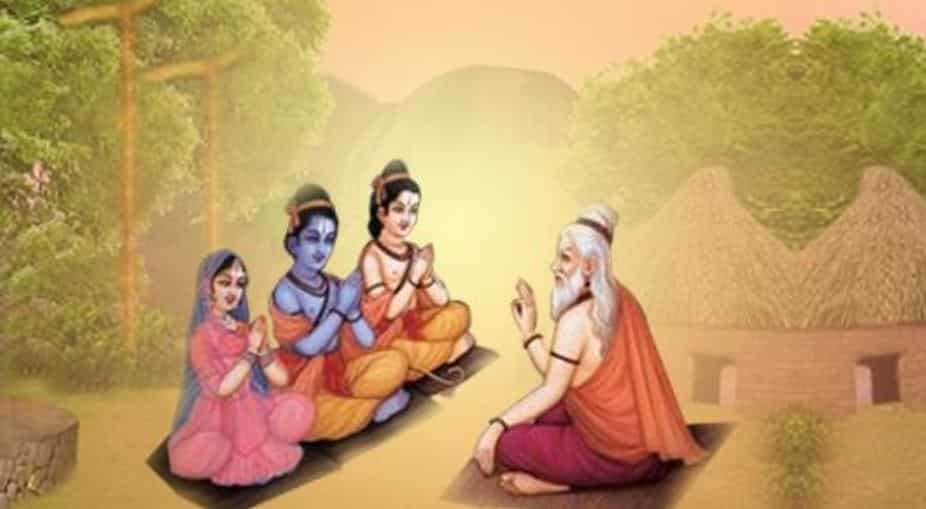
Atri or Attri is a legendary bard and scholar. Rishi Atri is said to be the ancestor of some Brahmin, Prajapatis, Kshatriya, and Vaishya communities who adopt Atri as their gotra. Atri is the Saptarishi (Seven Great Sages) in the seventh, i.e. the present Manvantara.
Family: When the sons of Brahma were destroyed by a curse of Shiva, Atri was born again from the flames of a sacrifice performed by Brahma. His wife in both manifestations was Anasuya. She bore him three sons, Datta, Durvasas, and Soma, in his first life, and a son Aryaman (Nobility), and a daughter, Amala (Purity), in the second. Soma, Datta, and Durvasa are the incarnations of the Divine Trinity Brahma, Vishnu, and Rudra (Shiva) respectively.
3. Angirasa Rishi
Angirasa is a rishi who, along with sage Atharvan, is credited to have formulated (“heard”) most of the fourth Veda called Atharvaveda. He is also mentioned in the other three Vedas.
Family: His wife is Surupa and his sons are Utathya, Samvartana, and Brihaspati
4. Pulaha Rishi
He was born from the navel of Lord Brahma. He was burned due to a curse made by Lord Shiva, then was born again in Vaivasvata Manvantara, this time from Agni’s hair.
Family: During his birth in the first Manvantara, Rishi Pulaha was married to another of Daksha’s daughters, Kshama (Apology). Together they had three sons, Kardama, Kanakapeetha, and Urvarivat, and a daughter named Peevari.
5. Pulutsya Rishi
He was the medium through which some of the Puranas was communicated to man. He received the Vishnu Purana from Brahma and communicated it to Parashara, who made it known to mankind. He was one of the Saptarishis in the first Manvantara.
Family: He was the father of Visravas who was the father of Kubera and Ravana, and all the Rakshasas are supposed to have sprung from him. Pulastya Rishi was married to one of Kardam ji’s nine daughters named Havirbhoo. Pulastya Rishi had two sons – Maharshi Agastya and Visravas. Vishravaa had two wives: one was Kaikesi who gave birth to Ravana, Kumbhakarna, and Vibhishana; and another was Ilavida and had a son named Kuber.
6. Krathu Rishi
Kratu appears in two different ages. In the Swayanbhuva Manvantara. Krathu was a Prajapati and a very dear son of Lord Brahma. He was also the son-in-law of Prajapati Daksha.
Family: His wife was named Santhati. It is said that he had 60,000 children. They were named as included in the Valakhilyas.
Rishi Kratu was again born in the Vaivaswata Manvantara because of Lord Shiva’s boon. In this Manvantara, he had no family. It is said that he was born from the hand of Lord Brahma. As he had no family and no children, Kratu adopted Agastya’s son, Idhvaaha. Kratu is considered as one of the Bhargavas.
7. Vashistha
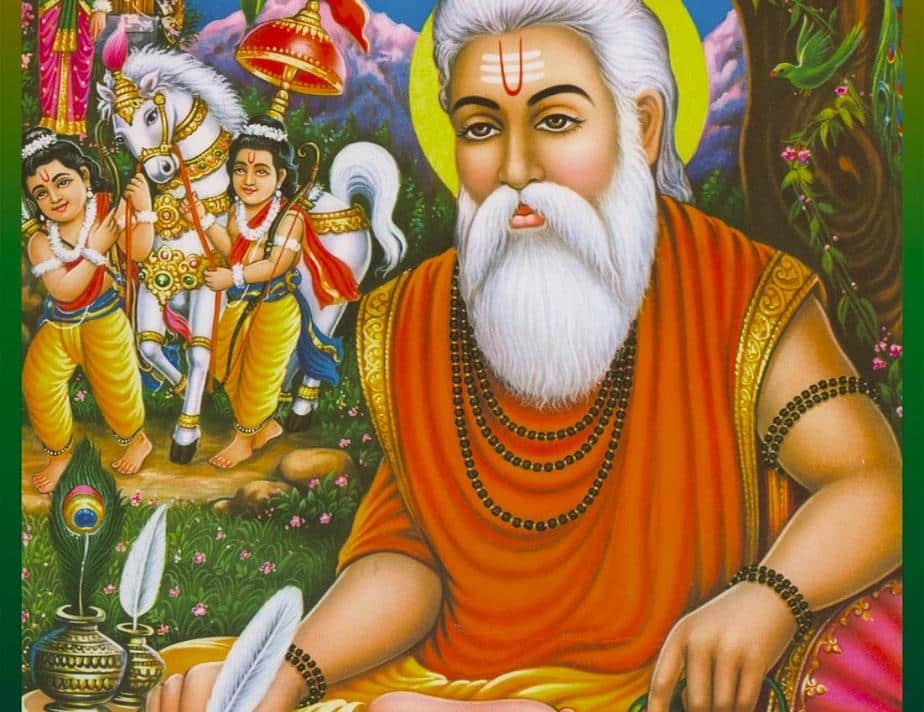
Rishi Vashistha is one of the Saptarishis in the seventh, i.e. the present Manvantara. He had in his possession the divine cow Kamadhenu, and Nandini her child, who could grant anything to their owners.
Vashistha is credited as the chief author of Mandala 7 of the Rigveda. Vashistha and his family are glorified in RV 7.33, extolling their role in the Battle of the Ten Kings, making him the only mortal besides Bhava to have a Rigvedic hymn dedicated to him. Another treatise attributed to him is “Vashistha Samhita” – a book on the Vedic system of electional astrology.
Family: Arundhati is the name of the wife of Vashista.
In cosmology, Mizar star is known as Vashistha and Alcor star is known as Arundhati in traditional Indian astronomy. The pair is considered to symbolize marriage and, in some Hindu communities, priests conducting a wedding ceremony allude to or point out the constellation as a symbol of the closeness marriage brings to a couple. Since Vasishta was married to Arundathi, he was also called Arundathi Natha, meaning the husband of Arundathi.
8. Prachethasa
Prachetasa is considered to be one of the most mysterious figures of Hindu history. According to the Puranas, Prachetasa was one of the 10 Prajapatis who was ancient sages and lawgiver. But there is also a reference to 10 Prachetas who were sons of Prachinabarthis and great-grandsons of Prithu. It is said that they lived for 10,000 years in a great ocean, very deeply engaged in meditation upon Vishnu and obtained from Him the boon of becoming the progenitors of mankind.
Family: They married a girl named Manisha, a daughter of Kanclu. Daksha was their son.
9. Bhrigu

Maharishi Bhrigu is the first compiler of predictive astrology, and also the author of Bhrigu Samhita, the astrological (Jyotish) classic. The adjectival form of the name, Bhargava, is used to refer to the descendants and the school of Bhrigu. Along with Manu, Bhrigu had made important contributions to ‘Manusmriti’, which was constituted out of a sermon to a congregation of saints in the state of Brahmavarta, after the great floods in this area, nearly 10,000 years ago.
Family: He was married to Khyati, the daughter of Daksha. He had two sons by her, named Dhata and Vidhata. His daughter Sri or Bhargavi married Vishnu.
10. Narada Muni
Narada is a Vedic sage who plays a prominent role in a number of Hindu texts, notably the Ramayana and the Bhagavata Purana. Narada is arguably ancient India’s most traveled sage with the ability to visit distant worlds and realms. He is depicted carrying a Veena, with the name Mahathi and is generally regarded as one of the great masters of the ancient musical instrument.
Narada Muni is described as both wise and mischievous, creating some of Vedic literature’s more humorous tales. Vaishnav enthusiasts depict him as a pure, elevated soul who glorifies Vishnu through his devotional songs, singing the names Hari and Narayana, and therein demonstrating bhakti-yoga.
11. Shatarupa
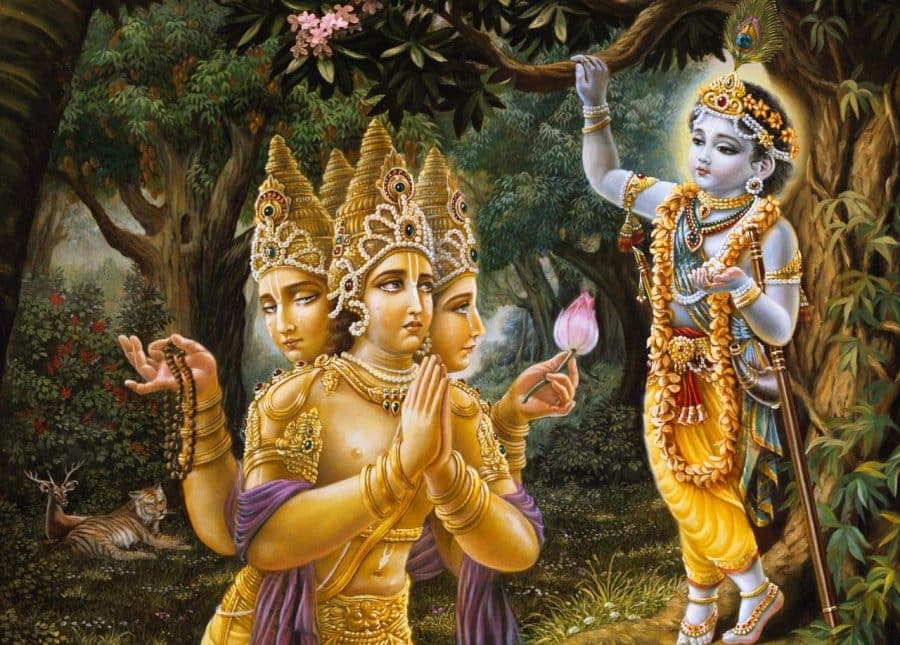
Brahma had one daughter Named Shatrupa – (one who can take a hundred forms) born from various parts of his body. She is said to be the first woman created by Lord Brahma. Shatarupa is the female portion of Brahma.
We are said to have descended from the 10 Prajapatis.


